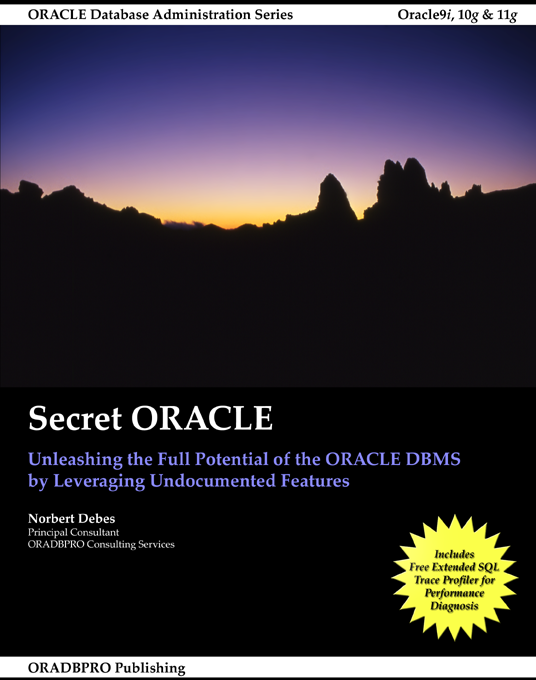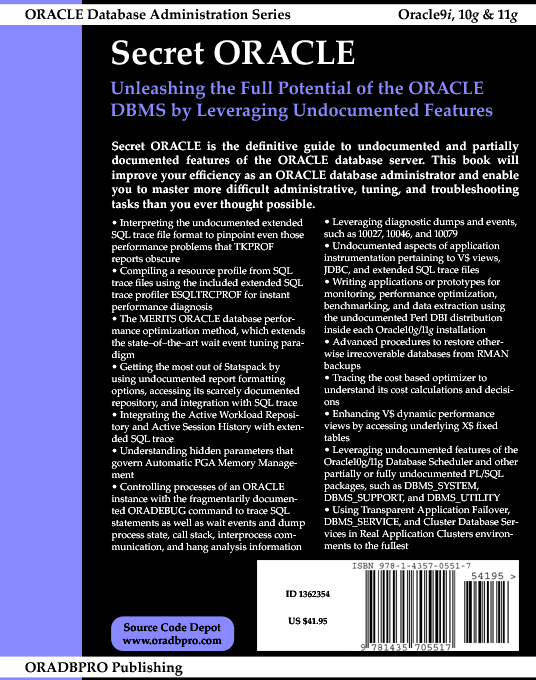|
|
|
Secret ORACLE is the definitive
guide to undocumented and partially documented
features of the ORACLE database server. This book
will improve your efficiency as an ORACLE database
administrator and enable you to master more
difficult administrative, tuning and
troubleshooting tasks than you ever thought
possible. Many undocumented features are very
stable, even more stable than numerous documented
features. The very useful SQL*Plus command
ORADEBUG, which has been around since Oracle7, is
a prime example. Hence the material presented in
the book will not become obsolete as the next
major release appears, but most of it will remain
useful for many years to come.
The book covers many undocumented features and
aspects of the ORACLE DBMS releases 9i, 10g, and 11g including
but not limited to:
- how pga_aggregate_target is implemented with
hidden parameters
- hidden parameters in general
- IND$, V$OBJECT_USAGE and index usage
monitoring
- events (trace, optimizer)
- Extended SQL trace file format reference (9i, 10g, 11g)
- how to leverage the sqlid emitted to
Oracle11g
SQL trace files with Statspack, AWR and ASH
- how to generate a resource profile from
extended SQL trace files using Perl (the book
includes the Perl program ESQLTRCPROF which is
better than TKPROF in many respects) to
diagnose performance problems
- Statspack (undocumented parameters, how to
link the hash value in SQL trace to Statspack)
- using the undocumented ORADEBUG command for
tracing, hang analysis, and performance
diagnostics
- application instrumentation for leveraging
tracing and statistics collection with
DBMS_MONITOR with a special look at JDBC
instrumentation
- the MERITS performance optimization method,
which extends the state of the art wait event
tuning paradigm
- undocumented aspects of V$ views
- X$ fixed tables
- undocumented packages (DBMS_SYSTEM,
DBMS_SUPPORT, DBMS_IJOB, DBMS_BACKUP_RESTORE)
and partially documented packages
(DBMS_SCHEDULER and external jobs,
DBMS_UTILITY)
- writing applications for monitoring,
performance optimization, benchmarking and
data extraction using the undocumented Perl
DBI distribution inside each Oracle10g/11g
installation
- undocumented aspects of Real Application
Clusters (removing the RAC option in case of
emergency, manual load rebalancing after node
failure with services and TAF)
Available online
at Lulu.com,
Amazon.com,
Amazon.de
(for customers within the EU), Barnes
&
Noble, and Borders
Secret
ORACLE is featured in the book review
section of the Northern
California Oracle Users Group Journal
(November 2008). The review
was written by Brian Hitchcock, a Senior
Oracle DBA at Sun Microsystems and a frequent
speaker at Oracle OpenWorld. Brian recommends Secret ORACLE
to other readers with DBA experience and is
convinced "that a junior DBA could benefit as
well". He is impressed by the amount of new
information he learned and by the overall quality:
"I just finished reading a book from Oracle Press
that had many errors, both typos and factual
errors. I was surprised that a self-published book
would have many fewer errors than a book from a
major publisher."
While he cautions the reader against actually
using undocumented features, he acknowledges that
the book does a great job at explaining the
undocumented aspects and inner workings of certain
documented features, e.g. PGA_AGGREGATE_TARGET,
V$SESSION_WAIT, V$OBJECT_USAGE, and Advanced
Queuing: "Learning about undocumented features can
help you use the normal features better."
This quote from Brian's review says it all: "How
much did I like this book? In the first 30 pages I
found so many things that I didn’t know but that I
think are worth knowing that I can’t describe them
all to you in this review. That’s how good this
book is."
Read the full review here.
Secret ORACLE
received an enthusiastic review
by DOAG News, a publication of the German Oracle Users
Group DOAG (volume 2/2008, ISSN 09 36-0360).
The reviewer was impressed by the amount and depth
of information on ORACLE database performance
optimization and praises the large collection of
highly useful scripts provided to the readers. The
chapter on Statspack was well received due to a
procedure for finding the most resource intensive
Statspack snapshots in a repository of hundreds or
even thousands of Statspack snapshots. The
reviewer also liked the chapter on the MERITS
Oracle database performance optimization method.
The MERITS method is a six-step approach (Measure,
assEss, Reproduce, Improve, forecasT, inStall) to
performance optimization that emphasizes
accurately measuring and diagnosing performance
problems thus eliminating trial and error. Click here
to read the review.
To encourage sales directly from the publisher Lulu.com
, readers who present a valid Lulu order number
and date to ORADBPRO Publishing will receive a
revised edition of the extended SQL trace profiler
ESQLTRCPROF. ESQLTRCPROF is a valuable
performance diagnosis tool which goes beyond the
capabilities of TKPROF. The enhanced version has
the following new features:
- accounting of elapsed time, cpu time, and
wait time per dependency level
- calculation of percentage of total response
time for each SQL or PL/SQL statement
- input file name and trace file header
included in output
- extraction of missing SQL statement texts
from cursor dumps (if present in trace file
due to an ORADEBUG dump command)
- support for trace files without database
calls (PARSE, EXEC, FETCH), e.g. from
background processes when analyzing a slow
roll forward with extended SQL trace
- millisecond precision for additional metrics
Please send valid Lulu order number and date by
e-mail to ORADBPRO Publishing to receive the
enhanced profiler (see tab Contact
for e-mail address).
|


|
|
|
|
|
|
|
|
|
|
|